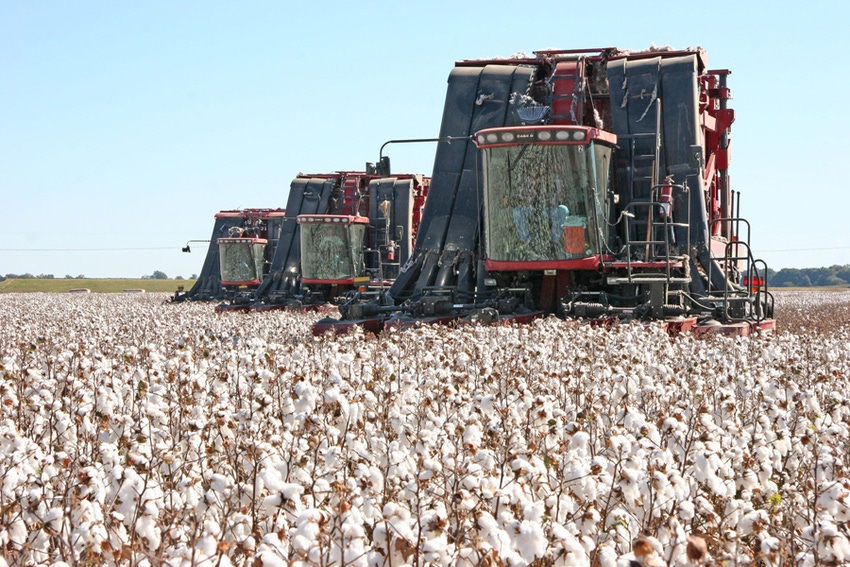
Cotton acreage, to no one’s surprise, will be up, significantly in some areas, for 2011.
State cotton specialists participating in a Dow/Phytogen Cottonseed dinner meeting on the cusp of the Beltwide Cotton Conferences in Atlanta Monday evening indicated all areas across the Southern cotton growing region will add acreage.
Some cotton will displace corn, specialists say, and some will compete with peanuts and soybeans for acreage. Specialists say cotton at $1 a pound is hard to beat with any other crop option.
Texas AgriLife Extension agronomist and cotton specialist Gaylon Morgan said Texas acreage could top 6 million for 2011, up 1 million acres from 2010.
“We made a really good crop in 2010, especially compared to 2009,” Morgan said. “We started off with good soil moisture, turned a little dry in May but had more yield loss from insects in the Texas Blacklands and South Texas than from weather.”
He said aflatoxin in corn and harvest problems with grain sorghum because of late rainfall may push Central and South Texas farmers to cotton in 2011. He anticipates the Rio Grande Valley could add 10 percent to 15 percent to 2010 acreage. A similar bump is expected for the Rolling Plains and estimates for High Plains acreage is also up.
“Central Texas cotton acreage could increase by30 percent,” Morgan said. “Overall, Texas planted acreage could top 6 million.”
Tennessee
Tennessee cotton farmers could add as many as 100,000 acres and could hit half-million planted in 2011, said University of Tennessee cotton specialist Chris Main.
Darren Dodds, Mississippi State University Extension cotton specialist, anticipates acreage to top 500,000, possibly to 550,000 in 2011. Most expansion will come from north of highway 82, Dodds said. Southern Mississippi has put a lot of acres into corn.
“Last year was very good for cotton,” he said.
Charlie Burmeister, Auburn University, said Alabama had a less than ideal cotton year, however. “For some farmers, it was the best year ever; for others it was the worst. Average state yield will be about 600 pounds. So for 2011, it depends on who you talk to as to how enthusiastic they are about cotton acreage.”
He said corn had a good year in 2010 and will compete for acreage. “But we’ve seen interest in cotton pickers in North Alabama. So we still have folks excited about cotton.”
Burmeister said farmers are concerned about Palmer pigweed. “We’re beginning to see it come in.”
Dale Monks, also an Auburn Extension cotton specialist, anticipates 350,000 planted acres for 2011.
Kansas cotton farmers likely will add acres in 2011, said Extension agronomist Stu Duncan. “Acres could range from 50,000 to 100,000,” Duncan said, “but I expect it to be nearer 100,000.”
He said 2010 was a good year for Kansas cotton, “the second highest average yield on record with some irrigated cotton making 3 to 3.5 bales per acre and netting more than $1,000 per acre.”
Area of concern may be dryland acreage in Southwest Kansas, he said. “Some of that area had the driest season ever.”
Georgia
Georgia acreage will increase from 1.3 million acres to 1.5, possibly 1.6 million, said Gary Collins, University of Georgia. “Acreage may depend to some degree on peanut contracts, but I think any increase in peanut acreage will come from corn or soybeans.”
In South Carolina, acreage could increase by 10 percent from 200,000 planted in 2010. “Most of the increase will come south of Santee-Cooper Lake,” said Michael Jones, Clemson University Extension specialist. Acreage increase also will come from competing crops, he said.
Tom Barber, Arkansas cotton specialist, said the 2010 cotton crop yielded “okay, considering conditions. We had a lot of 1,400 to 1,600 pound per acre yields but we also had some in the 2-bale range, and we’ll average about 1,070 pounds.”
Barber expects a 10 percent to 15 percent increase in 2011. “Dollar cotton looks very good.”
Bill Robertson, with the National Cotton Council, told cotton specialists to “encourage farmers to plant as much cotton as they can and then to come to Beltwide. Acreage will be up across the Belt in 2011,” Robertson said.
About the Author(s)
You May Also Like






